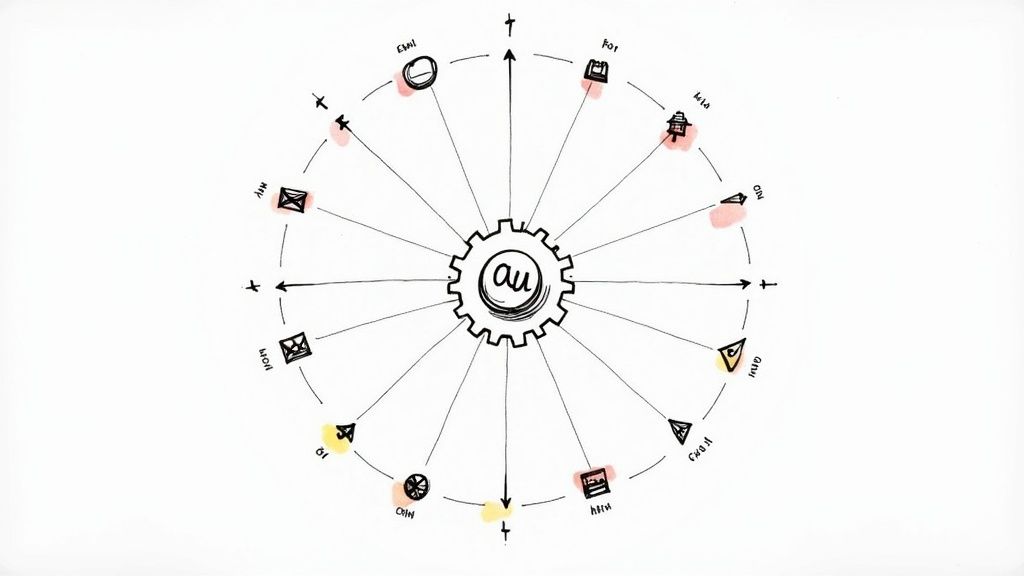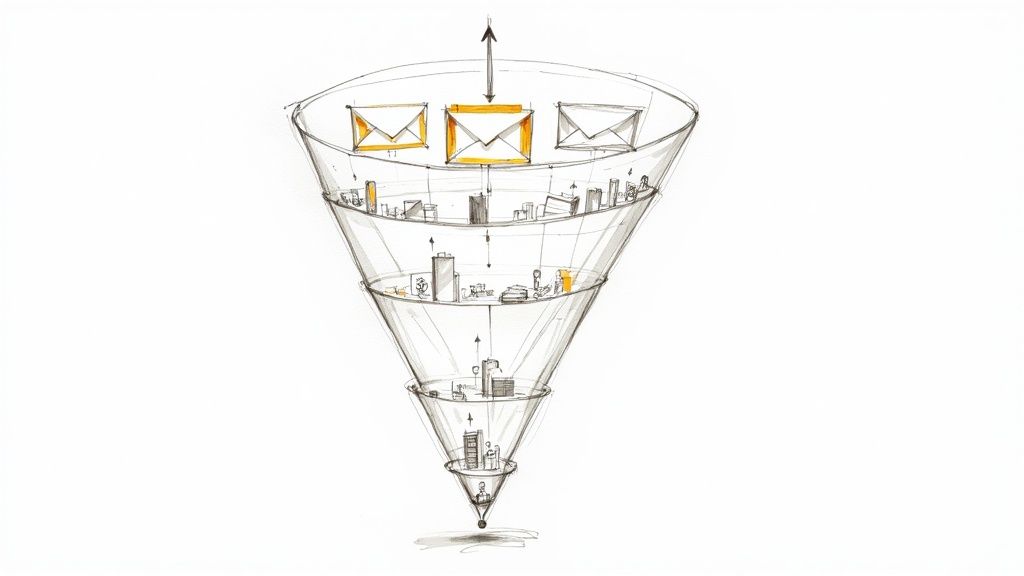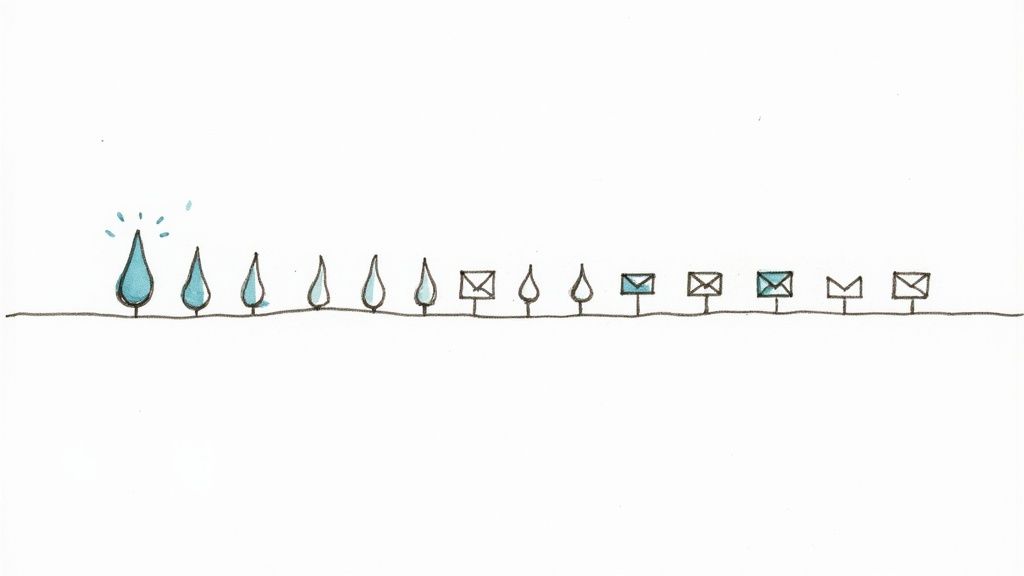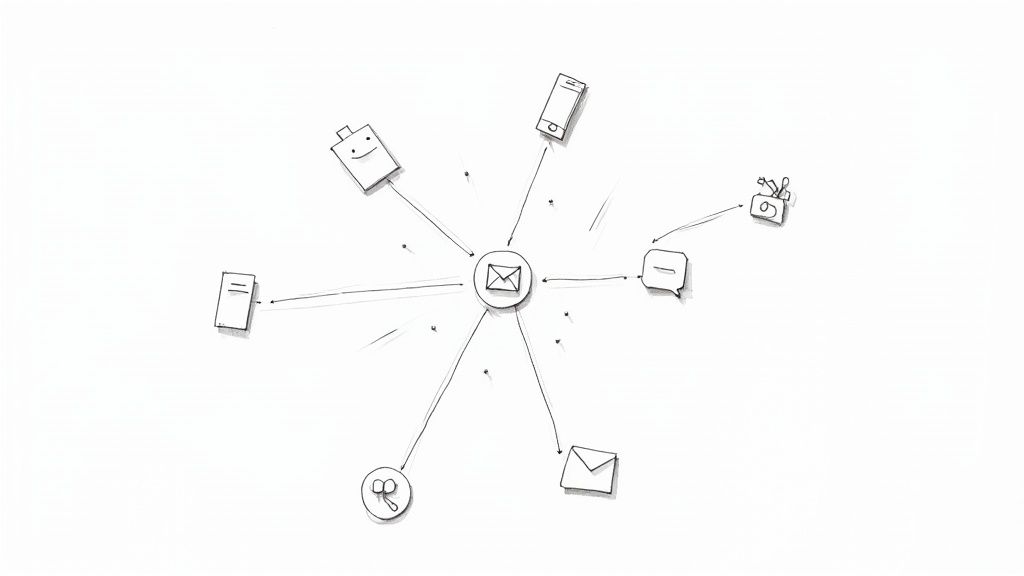10 Potent Marketing Automation Strategies for 2025

In today’s competitive market, manual marketing tasks are no longer sustainable. The key to scaling your efforts, personalizing customer experiences, and driving significant ROI lies in adopting intelligent marketing automation strategies. This guide moves beyond generic advice to provide ten actionable approaches that you can implement immediately. We’ll explore how to set up smart workflows that not only save time but also create more meaningful connections with your audience at every stage of their journey.
To truly unlock growth with smarter marketing automation, it’s essential to not just understand strategies but also to implement proven marketing automation best practices that ensure efficiency and effectiveness. From nurturing new leads to re-engaging past customers, the tactics covered here are designed for immediate impact. For each strategy, we will demonstrate how an intuitive tool like Sagekit can translate these concepts from theory into reality. You’ll learn how to build powerful automations using simple, natural language prompts, allowing you to reclaim valuable hours for high-level strategic work instead of getting bogged down in repetitive tasks. Get ready to transform your marketing operations and drive measurable results.
1. Lead Nurturing Campaigns
Lead nurturing is a cornerstone of effective marketing automation strategies. It involves building and strengthening relationships with prospects at every stage of their journey. Instead of a one-size-fits-all approach, lead nurturing uses automated, personalized communication to guide potential customers from initial awareness to making a purchase decision. This strategy ensures you provide the right information at the right time, addressing their specific pain points and needs as they evolve.

The primary goal is to maintain engagement with leads who aren’t yet ready to buy, building trust and keeping your brand top of mind. By automating this process, you can scale your relationship-building efforts without losing the personal touch that converts prospects into loyal customers.
How to Implement This Strategy
To effectively nurture leads, you need a system that responds to their behavior. Start by segmenting your audience based on their interests, demographics, or actions they’ve taken, such as downloading an ebook or visiting a specific webpage.
- Create Buyer Persona Tracks: Develop unique email sequences for different buyer personas. A startup founder has different concerns than a marketing manager at a large enterprise, so your content should reflect that.
- Use Behavioral Triggers: Set up automations that trigger when a lead takes a specific action. For example, if a contact visits your pricing page three times, automatically send them an email with a case study or a special offer.
- Implement Lead Scoring: Assign points to leads based on their engagement and demographic data. This helps prioritize high-intent prospects, allowing your sales team to focus their efforts on those most likely to convert.
Sagekit in Action: A B2B software company uses Sagekit to create a nurturing campaign for new webinar registrants. After the webinar, an automated workflow sends a series of four emails. The first shares the recording, the second a relevant case study, the third an invitation to a one-on-one demo, and the fourth a follow-up from a sales representative. This sequence keeps leads engaged and moves them efficiently through the funnel.
2. Behavioral Trigger Marketing
Behavioral trigger marketing uses customer actions to automatically initiate targeted marketing responses. This strategy moves beyond static campaigns, monitoring user interactions across your website, app, or emails to deliver timely and relevant messages based on specific behaviors like page visits, cart abandonment, or engagement patterns. It’s a powerful way to capitalize on user intent in real-time.

The core principle is to react to what a user does, not just who they are. By responding to actions, you create a dynamic, personalized experience that feels less like marketing and more like a helpful conversation. This approach boosts engagement and conversion rates by delivering the right message at the exact moment a customer is most receptive.
How to Implement This Strategy
Effective behavioral triggers require a clear understanding of high-intent customer actions. Begin by identifying key moments in the customer journey where a timely message could make a significant impact, such as a user viewing the same product multiple times or abandoning their shopping cart.
- Identify High-Impact Triggers: Start with the most valuable user actions. A cart abandonment trigger, for instance, can recover otherwise lost revenue. Other powerful triggers include repeat visits to a pricing page or downloading a specific resource.
- Personalize the Message: Use the behavioral data to tailor your communication. If a user abandons a cart containing a specific blue sweater, your automated email should feature that exact item, not generic product recommendations.
- Set Frequency Caps: Monitor how often triggers fire for a single user. Sending too many automated messages can feel overwhelming and intrusive, so set appropriate limits to maintain a positive customer experience.
Sagekit in Action: An e-commerce store uses Sagekit to set up a browse abandonment workflow. When a logged-in user views a product page three times in one week without making a purchase, Sagekit automatically sends an email. The email includes the viewed product, a few similar recommendations, and a limited-time 10% discount code to encourage them to complete the purchase.
3. Customer Segmentation and Personalization
Among the most powerful marketing automation strategies is customer segmentation and personalization. This approach involves dividing your audience into distinct groups based on shared characteristics like demographics, behavior, or purchase history. By doing so, you can move beyond generic messaging and deliver highly relevant content, offers, and experiences that resonate on a personal level.

The core goal is to make each customer feel understood and valued, which significantly boosts engagement, conversion rates, and long-term loyalty. Automation makes it possible to manage these complex segments and deliver personalized communication at scale, a task that would be impossible to handle manually.
How to Implement This Strategy
Effective personalization starts with clean, well-organized data. Use your marketing automation platform to collect and categorize customer information, then build workflows that deliver tailored experiences based on segment criteria.
- Implement Dynamic Content: Create email templates with dynamic content blocks that change based on the recipient’s segment. A retail brand could show different product recommendations based on a customer’s past purchases or browsing history.
- Use RFM Analysis: Segment customers based on Recency, Frequency, and Monetary value. This helps you identify your most valuable customers, those at risk of churning, and new customers who need nurturing.
- Leverage Behavioral Data: Group users based on actions they take on your website or app. For example, create a segment for users who abandoned their shopping cart and send them an automated reminder with a special offer.
Sagekit in Action: An e-commerce store uses Sagekit to automatically segment customers who purchase running shoes. These customers are added to a “Runner” segment and receive a targeted follow-up campaign featuring content like marathon training tips, new running gear arrivals, and exclusive discounts on athletic apparel, driving repeat purchases and enhancing customer loyalty.
4. Drip Campaign Automation
Drip campaigns are pre-written sequences of messages sent automatically to prospects or customers over time. This approach allows you to “drip” content at predetermined intervals or based on specific triggers, maintaining consistent communication without manual intervention. These campaigns are fundamental to many marketing automation strategies, designed to educate, nurture, and convert leads through strategic content delivery.

The primary goal is to keep your audience engaged with relevant, timely information. Whether welcoming new subscribers, educating users about a product, or re-engaging inactive contacts, automated drip campaigns ensure a consistent and purposeful communication flow.
How to Implement This Strategy
Effective drip campaigns require thoughtful planning around the customer journey. You must anticipate what information your audience needs at each stage and deliver it in a digestible format. Start by mapping out the sequence and defining the goal for each message.
- Plan Content Around Journey Stages: Create distinct drip sequences for different phases. A welcome series for new subscribers should be different from a product education series for recent buyers.
- Use Clear, Compelling Subject Lines: Each email in your sequence needs to capture attention. Craft subject lines that create curiosity or clearly state the value inside the message.
- Include Strong Calls-to-Action (CTAs): Every message should guide the recipient toward the next step, whether it’s reading a blog post, watching a video, or booking a demo.
Sagekit in Action: An online course creator uses Sagekit to deliver a free 5-day email course. When a user signs up, an automated drip campaign sends one lesson per day. The workflow checks if the user opened the previous email before sending the next, ensuring engagement. The final email includes a special offer to purchase the full course, converting nurtured leads into paying customers.
5. Lead Scoring and Qualification
Lead scoring is one of the most powerful marketing automation strategies for aligning sales and marketing teams. It involves assigning points to leads based on their demographic information, firmographic data, and behavioral engagement with your brand. This automated system helps you identify which prospects are most sales-ready, allowing your team to focus their efforts on high-value opportunities.
The primary goal is to create a clear, data-driven method for prioritizing leads. By automatically qualifying prospects, you can ensure that the sales team receives a steady flow of high-intent leads, improving conversion rates and making the entire funnel more efficient.
How to Implement This Strategy
A successful lead scoring model requires collaboration between marketing and sales to define what makes a lead valuable. Start by identifying the key attributes and actions that correlate with a successful sale and assign point values accordingly.
- Define Scoring Criteria: Combine explicit data (like job title or company size) and implicit data (like website pages visited or emails opened). For instance, a C-suite executive from a target industry might receive more points than an intern.
- Set Score Thresholds: Establish clear thresholds that trigger specific actions. For example, once a lead reaches 50 points, they are automatically added to an aggressive nurturing track. At 100 points, they are flagged as a Marketing Qualified Lead (MQL) and assigned to a sales rep.
- Incorporate Negative Scoring: Subtract points for actions that indicate a lack of interest or fit, such as unsubscribing from emails, visiting the careers page, or having a personal email address. This prevents lead scores from becoming inflated.
Sagekit in Action: An e-commerce platform uses Sagekit to score leads based on their on-site behavior. A prospect earns +10 points for viewing a product demo, +5 for visiting the pricing page, and -15 if their email domain is from a competitor. Once a lead’s score surpasses 80, Sagekit automatically sends their profile to the sales team’s CRM with a high-priority tag and notifies the assigned rep via Slack.
6. Cart Abandonment Recovery
Cart abandonment recovery is one of the most profitable marketing automation strategies for e-commerce businesses. It targets customers who add items to their online shopping cart but leave the site without completing the purchase. This strategy uses automated, triggered email sequences to re-engage these high-intent shoppers and guide them back to finalize their transaction.

The primary goal is to reclaim lost revenue by addressing common reasons for abandonment, such as unexpected shipping costs or simple distractions. By automating this process, you can systematically convert near-misses into sales and significantly boost your overall conversion rate without manual intervention.
How to Implement This Strategy
A successful recovery sequence is timely, persuasive, and helpful. It reminds shoppers what they left behind and makes it easy for them to pick up where they left off.
- Trigger Timely Emails: Send the first reminder email within 1-3 hours of abandonment while the purchase is still top of mind. Follow up with a second or third email over the next few days.
- Showcase Abandoned Products: Include high-quality images and direct links to the items left in the cart. This visual reminder is crucial for reigniting the customer’s initial interest.
- Create a Sense of Urgency: Use language that implies scarcity, such as “Your items are selling fast!” or “Don’t miss out.” You can also offer a limited-time discount in a later email to incentivize completion.
Sagekit in Action: An online apparel store uses Sagekit to trigger a three-part cart recovery workflow. The first email, sent one hour after abandonment, is a simple reminder. The second, sent 24 hours later, includes customer reviews for the abandoned items. The final email, sent after 48 hours, offers a 10% discount to close the sale. This automated sequence recovers over 18% of abandoned carts.
7. Cross-Channel Marketing Automation
Cross-channel marketing automation is the art of orchestrating a unified customer experience across multiple touchpoints. This strategy goes beyond single-channel campaigns by creating a consistent and interconnected conversation with your audience on platforms like email, social media, SMS, and web push notifications. It ensures your messaging is coherent, timely, and contextually relevant, no matter where your customer chooses to interact.
The primary objective is to create a seamless customer journey that feels like a single, ongoing dialogue. By integrating channels, you can reinforce your message and maximize engagement opportunities, meeting customers on their preferred platforms and guiding them smoothly toward conversion.
How to Implement This Strategy
A successful cross-channel approach requires a central hub to manage and track customer interactions across all platforms. The key is to let customer behavior on one channel influence the communication they receive on another.
- Map the Customer Journey: Identify all potential touchpoints a customer might have with your brand and plan how different channels will work together at each stage.
- Centralize Customer Data: Use a platform that consolidates data from all channels to get a 360-degree view of each customer. This allows for more personalized and context-aware messaging.
- Use Channel-Specific Triggers: Create workflows that connect channels. For example, if a user clicks a link in an email but doesn’t convert, you could trigger a retargeting ad on social media a day later.
Sagekit in Action: An e-commerce brand uses Sagekit to recover abandoned carts. When a shopper leaves items in their cart, an automated workflow first sends a reminder email. If the email is not opened within 24 hours, an SMS with a special discount code is triggered. This multi-channel sequence significantly increases the cart recovery rate by reaching customers on the most effective channel.
8. Win-Back and Re-engagement Campaigns
Win-back campaigns are one of the most cost-effective marketing automation strategies available. It is far easier to reactivate a past customer than to acquire a new one. These automated sequences are designed to re-engage inactive subscribers or dormant customers who have stopped interacting with your brand, helping to reduce churn and recover lost revenue.
The primary goal is to remind these contacts of the value your brand offers and incentivize them to return. By automating personalized messages, special offers, and compelling content, you can efficiently rekindle these relationships and bring lapsed customers back into the fold without manual intervention.
How to Implement This Strategy
A successful re-engagement strategy relies on timing and value. Begin by identifying segments of your audience that have become inactive, defining clear thresholds for what “inactive” means for your business, such as 90 days without an email open or a purchase.
- Define Inactivity Triggers: Set up workflows that automatically trigger when a contact meets your inactivity criteria. This could be based on their last purchase date, last login, or last email engagement.
- Create a Value-Driven Sequence: Develop a multi-step email series that acknowledges their absence. Start with a simple “we miss you” message, followed by an exclusive offer or a survey asking for feedback on why they left.
- Automate List Cleaning: For contacts who do not re-engage after the campaign, create a final automation that gives them an option to stay subscribed. If they still don’t respond, automatically move them to a suppression list to maintain good list hygiene.
Sagekit in Action: An e-commerce brand uses Sagekit to launch a win-back campaign targeting customers who haven’t purchased in six months. The automation sends an email with a personalized “We’ve missed you!” subject line and a unique 15% discount code. If they don’t engage, a second email follows a week later highlighting new product arrivals based on their past purchase history, successfully reactivating 18% of the dormant segment.
9. Social Media Automation and Scheduling
Maintaining an active, engaging social media presence is crucial, but it can be incredibly time-consuming. Social media automation uses specialized tools to schedule posts in advance, monitor brand mentions, and manage engagement across multiple platforms. This strategy ensures a consistent brand voice and frees up your team to focus on creating quality content and engaging in meaningful, real-time conversations.
The main goal is to streamline social media management, optimize posting times for maximum reach, and ensure you never miss an opportunity to connect with your audience. By automating repetitive tasks, you can implement a more strategic and less reactive social media plan, making it a vital component of modern marketing automation strategies. For those looking to dive deeper, a guide on how to automate social media posts the smart way can provide valuable insights.
How to Implement This Strategy
Effective social media automation is about smart scheduling and monitoring, not just broadcasting content. Start by creating a content calendar that outlines your themes, post types, and target platforms for the upcoming weeks or months.
- Use a Scheduling Tool: Employ a platform to schedule posts for optimal times when your audience is most active. This ensures consistent visibility without requiring you to be online 24/7.
- Set Up Keyword Monitoring: Create automated alerts for mentions of your brand, competitors, or key industry terms. This allows you to join relevant conversations and manage your reputation proactively.
- Balance Automation with Real-Time Engagement: While scheduling posts is efficient, genuine interaction is what builds community. Dedicate time daily to respond to comments and messages personally.
Sagekit in Action: An e-commerce brand uses Sagekit to connect their social media management tool with their CRM. When a user with a high customer lifetime value mentions them on Twitter, an automation creates a high-priority task for a community manager to engage with them personally and offer a unique discount code, turning a happy customer into a vocal brand advocate.
10. Customer Lifecycle Marketing
Customer lifecycle marketing is a holistic approach that uses automation to deliver personalized experiences across the entire customer journey. This strategy moves beyond simple acquisition and focuses on nurturing relationships from initial awareness to long-term advocacy. By understanding where a customer is in their lifecycle, you can provide relevant content and offers that deepen their engagement and maximize their lifetime value.
The goal is to create a seamless, cohesive experience that guides customers from one stage to the next, building loyalty and turning them into brand champions. Automating this process ensures consistent communication and allows you to scale personalized interactions as your customer base grows.
How to Implement This Strategy
A successful lifecycle strategy requires a clear map of your customer’s journey and specific goals for each stage. Start by defining the key phases, from prospect to advocate, and identifying the triggers that move a customer from one to the next.
- Map Your Lifecycle Stages: Define distinct stages such as Awareness, Acquisition, Onboarding, Retention, and Advocacy. Outline the key customer actions and business goals for each phase.
- Create Stage-Specific Content: Develop automated campaigns with messaging tailored to each lifecycle stage. For instance, a new customer might receive a welcome series, while a long-time user gets an exclusive offer or an invitation to a loyalty program.
- Use Predictive Analytics: Leverage automation tools to analyze customer data and predict when they are likely to churn, upgrade, or become an advocate. This allows you to proactively trigger the right marketing actions.
Sagekit in Action: An e-commerce brand uses Sagekit to manage its entire customer lifecycle. When a customer makes their first purchase, an automated onboarding sequence is triggered. After 90 days, the system checks their purchase history and automatically enrolls them in a VIP segment if they meet the criteria, unlocking exclusive discounts and early access to new products. This strategy has increased repeat purchase rates by 25%.
Marketing Automation Strategies Comparison Table
| Strategy | Implementation Complexity 🔄 | Resource Requirements ⚡ | Expected Outcomes 📊 | Ideal Use Cases 💡 | Key Advantages ⭐ |
|---|---|---|---|---|---|
| Lead Nurturing Campaigns | High - complex setup and ongoing optimization | Significant content creation and maintenance | Increased conversion rates (+50%), better lead quality | Relationship building throughout sales funnel | Scalable relationship building, consistent engagement |
| Behavioral Trigger Marketing | High - requires robust tracking & data systems | Advanced technology for real-time tracking | Higher engagement due to timely, relevant messages | Real-time, behavior-based marketing responses | Improved personalization, reduced manual effort |
| Customer Segmentation & Personalization | High - complex data analytics and management | Extensive customer data and analytics | Higher engagement and ROI, improved loyalty | Targeted campaigns for diverse customer groups | Enhanced customer experience, predictive segmentation |
| Drip Campaign Automation | Medium - planned sequences with some customization | Content creation and basic automation tools | Consistent communication, higher conversions | Timed lead nurturing and education | Scalable, cost-effective, measurable |
| Lead Scoring and Qualification | Medium to High - model refinement required | Data and CRM integration | Improved sales focus, higher conversion efficiency | Prioritizing leads for sales follow-up | Objective prioritization, better marketing-sales alignment |
| Cart Abandonment Recovery | Low to Medium - requires e-commerce integration | Moderate technical integration and content | Recovers ~15% abandoned carts, improved conversions | E-commerce sites reducing cart abandonment | High ROI, targets ready-to-buy customers |
| Cross-Channel Marketing Automation | High - complex integrations across platforms | Significant technology and data unification | Increased reach, consistent customer experience | Multi-touchpoint campaigns across various channels | Optimized channel mix, comprehensive journey tracking |
| Win-Back and Re-engagement Campaigns | Medium - automation with personalized messaging | Content and data analysis | Reactivation of inactive customers, reduced churn | Re-engaging dormant users | Cost-effective retention, list cleaning benefits |
| Social Media Automation & Scheduling | Medium - tools setup with ongoing monitoring | Social media management platforms | Consistent posting, time/resource efficiency | Maintaining active social presence | Global reach, posting optimization |
| Customer Lifecycle Marketing | High - extensive cross-department coordination | Significant customer data and strategic planning | Maximized lifetime value, improved retention | End-to-end customer journey marketing | Structured lifecycle approach, predictive modeling |
From Strategy to Action: Your Next Step in Automation
We’ve explored a comprehensive landscape of powerful marketing automation strategies, from nurturing new leads and scoring their intent to recovering abandoned carts and re-engaging past customers. Each tactic, whether it’s behavioral trigger marketing or hyper-personalized segmentation, offers a direct path to a more efficient, scalable, and impactful marketing engine. The common thread connecting all these approaches is a shift from manual, repetitive work to intelligent, data-driven systems that operate around the clock.
The true power of these strategies isn’t just in saving time; it’s about creating better customer experiences at scale. By automating the right touchpoints, you ensure every prospect and customer receives timely, relevant communication that speaks directly to their needs and position in their journey with your brand. This consistency builds trust, fosters loyalty, and ultimately drives significant revenue growth.
Key Takeaways for Your Automation Journey
As you move from reading to implementation, keep these core principles in mind:
- Start with a Goal, Not a Tool: Before building any workflow, define what you want to achieve. Are you trying to increase conversion rates for new trials? Reduce customer churn? Your objective will determine which strategy is the right starting point.
- Automation Enhances, It Doesn’t Replace: The goal of automation is to handle the predictable, data-heavy tasks, freeing up your team for what humans do best: building relationships, strategic thinking, and creative problem-solving.
- Data is Your Foundation: Successful automation relies on clean, accessible data. Whether you’re segmenting an audience or triggering a behavioral email, the quality of your inputs will directly affect the quality of your results.
Your Actionable Next Steps
Feeling inspired but not sure where to begin? Don’t let the sheer number of options lead to paralysis. The most effective way to start is by picking one high-impact area and building from there.
Consider this simple framework to choose your first project:
- Identify Your Biggest Bottleneck: Where are you losing the most time or potential revenue? Is it in manually qualifying leads, or are too many shoppers abandoning their carts?
- Select a Corresponding Strategy: Match your bottleneck to one of the strategies discussed. For lead qualification issues, start with Lead Scoring. For lost sales, implement a Cart Abandonment Recovery workflow.
- Launch, Measure, and Iterate: Implement your first automated workflow. Monitor its performance, gather data, and look for opportunities to refine and improve it over time.
Mastering these marketing automation strategies transforms your business from a reactive organization into a proactive one. It allows you to anticipate customer needs, deliver value precisely when it’s needed most, and build a sustainable engine for growth. The journey begins not with a massive overhaul, but with a single, well-chosen automated workflow. The question is, which one will you build first?
Ready to turn these strategies into reality without the technical headaches? With Sagekit, you can build sophisticated automation workflows just by describing your goal in plain English. See how easy it is to implement advanced marketing automation strategies by exploring Sagekit today.